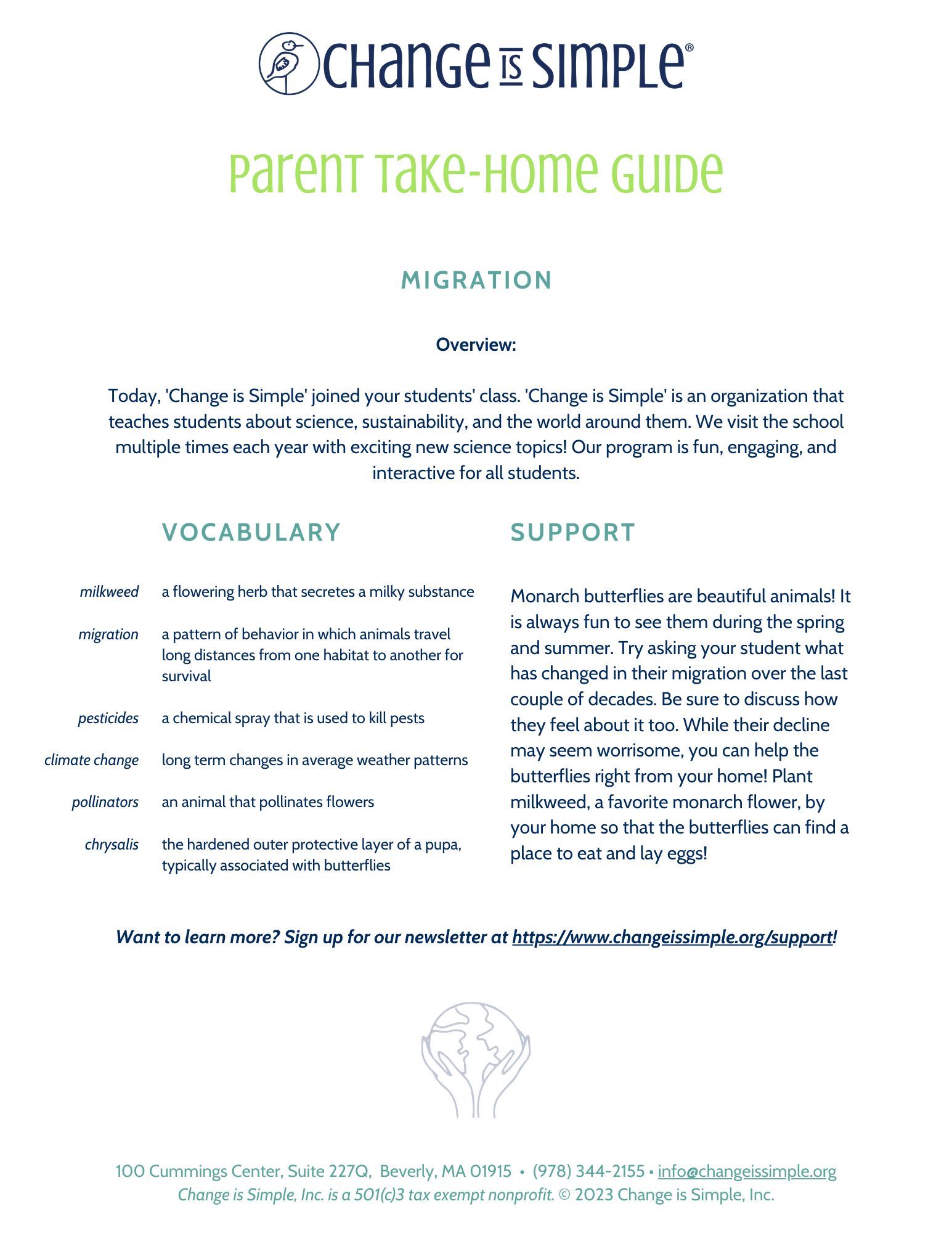HUMAN IMPACTS ON monarch MIGRATION
Lesson Objectives:
At the end of the workshop, students will be able to:
Define migration and learn reasons why animals migrate
Work together in teams to solve problems
Understand the life cycle of a monarch butterfly
Be able to come up with concrete ideas about how to help important pollinators that migrate
Essential Questions:
What is migration?
Why do monarch butterflies migrate?
What do monarch butterflies need to survive?
How do humans affect migration patterns and routes?
Explore our resources
Click on the images to access each resource (available as a PDF or webpage)
Take-Home Guide
Information for parents & legal guardians (available in English and Spanish).
Información para padres de familia y tutores legales (disponible en Inglés y Español).
Standards Alignments
Explore the ways our program aligns with CCSS + NGSS standards.
Vocabulary
A review of terms covered during the CiS workshop.
Monarch Migration Map
In this activity, students will color a 2020 monarch butterfly migration map and will answer a few questions related to the map and their Change is Simple lesson!
Social Emotional Learning
In this activity, students will write a poem from the perspective of a migrating monarch butterfly. They will highlight some of the challenges these butterflies are facing and how the butterflies may be feeling.
Lesson Reflection
Print and send home this reflection activity to show families what their student learned.
Background Information
How to survive winter
Animals have a few different options for how they can survive the winter. They can hibernate! They won’t leave their habitat, but will most likely be sleeping for most of their time throughout the colder months. They can stay and adapt! Still active, they search for food wherever they can, and might even change the coloring of their fur. Or they can migrate! Some animals make a long trek to a warmer location to escape the cold and find more food. Migration is a huge journey for any animal, but in this lesson we focus on the monarch butterfly’s migration as it is one of the most impressive migrations of all.
Migrate to Mexico
Monarch butterflies undertake the extraordinary journey south to Mexico as a survival strategy ingrained in their life cycle. The primary reason behind this migration is the need to escape harsh winter conditions in their breeding grounds of North America. As temperatures drop, the availability of nectar and other essential resources diminishes, making it challenging for these delicate creatures to thrive. Monarchs migrate every fall to Mexico for about two months. They then find themselves convening together on the , where they live in hibernation for about six months. After these six months are up, in February/ March, they will make the journey back again. This has been happening for many years, and the Monarch Butterfly migration is something that people have been studying and tracking for a very long time.
Impacting the population
Unfortunately, because of things like climate change, pesticides, and human development, the population of monarch butterflies successfully migrating to Mexico is dwindling every year. Climate change can cause seasons to feel different than we expect them to. Warmer winters, rainier falls, long cold springs, etc. This can make it difficult for animals to migrate at the right time of year. Also, with climate change comes more extreme weather events like tornadoes, storms, hurricanes, and blizzards. This greatly impacts migration routes as well. Pesticides are very strong chemicals people spray on lawns to keep mosquitoes away, or to help crops grow. When pollinators like bees and butterflies come in contact with them, they do not survive.
How to help
Luckily, there are ways we can help! Monarch caterpillars only eat milkweed plants, so planting milkweed helps the caterpillar populations before they migrate. Choosing to stay away from pesticides as much as possible in your own gardens and lawns, and also buying organic food helps monarchs and other pollinators greatly. Try setting up a pollinator paradise in your yard! A space where you don’t mow or spray and chemicals and wildflowers can grow freely!













